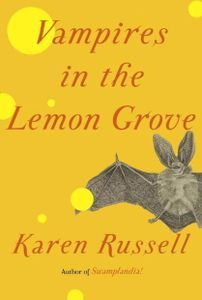
Boy vs. Girl: VAMPIRES IN THE LEMON GROVE
This is a guest post by Casey Peterson and Marisa Atkinson.
Casey is a publishing assistant at Graywolf Press in Minneapolis, but he lives in Saint Paul. In past lives, he’s been a cashier, a bookseller, a Peace Corps volunteer, and a street fighter. He rides a single-speed bike, and is a thesis away from a master’s degree. Follow him on Twitter @case_face. Marisa is a publicist for Graywolf Press, and has previously written for Bookslut and Publishers Weekly. She’s never read The Great Gatsby. Follow her on Twitter @totesmarisa.
Welcome to the inaugural installment of Boy vs. Girl, in which we (Marisa Atkinson and Casey Peterson) read and debate new books at least one of us is really excited about. We’ll each pick one new book a month, and the other is contractually obligated to read it all the way through. Then we’ll dissect them–the good, the bad, and the snarky! Keep up with us on Twitter @BoyvsGirlBR!
There will be some minor spoilers here, but we’ll try not to give too much away. You’ve officially been warned, Rioters!
* * *

Casey: You’re right: this collection was really good. Although, I think it stops short of amazing, but I really enjoyed reading it, and my reaction at the end was “Wow. Fantastic.”
Marisa: This is my first time reading Karen Russell, but you’re a megafan. In your opinion, how does this collection rank with St. Lucy’s Home for Girls Raised By Wolves and Swamplandia?
Casey: Good question, and I’m going to try and be really honest with my answer. Of Russell’s three books, I think this is my third favorite. But that’s not the same as least favorite, really. St. Lucy’s is the Karen Russell gateway drug: Her characters, sense of place, and wild imagination are on full display. It’s the first hit that makes you want more and more, but every subsequent taste is never quite the same as the first.
Swamplandia is a great novel. I was really invested in Ava Bigtree, and the whole Bigtree family. It’s a solid adventure story, with a huge scope, but Russell might have tried to do too much. Swamplandia’s story dragged at points, and the end was problematic (I forgive these things, though, since it was a first novel and endings are tough). Do you know what I mean?
So why is Vampires third? Like I said, it’s a fantastic collection. They’re all good stories, and might have been great stories in someone else’s collection. But they’re not all great Karen Russell stories.
Marisa: Not to get all pretentious, but this is almost exactly what the New York Times Book Review said in their review of Vampires.
Casey: I feel like you comparing me to the New York Times Book Review is less of a pretentious statement than it is a statement that secretly calls me pretentious. Casey=Liberal Media Elitist. Thanks.
Marisa: I think you may be projecting…But how rad to be a writer that’s so good the reading public doesn’t compare you to other writers, they can only compare you to yourself.
Casey: Yeah, it’s high praise. But then I start to worry that we’re all typecasting Karen Russell: “Oh, she’s the one who writes weird stories.” I’m guilty of it, and I’ll be guilty of it in this review. Promise: I will judge Karen’s next book purely on its own merits (but I will go to it with all of my appreciation for her previous books. So.).
Marisa: About halfway through my reading, I was convinced that “Reeling for the Empire” was going to be my favorite of the collection. That story had so many compelling levels to pick apart and discuss–girlhood! feminism! loss of innocence! horror! art! corruption! the human cost of industry! I feel like you could structure an entire class session around that one story. It still haunts me. I think about it all the time!
But then I read “The New Veterans” and was completely. blown. away.
Casey: Yeah, I liked “Reeling for the Empire.” It’s so weird. And so sad. This story would have been right at home in her first collection. Not having read Russell’s work before, did you know what to expect? That story really creeps up on you, right?
Marisa: I had read a bit of St. Lucy’s, so I did know to expect the fantasy/magical realism angle. But “Reeling for the Empire” had that really creepy gothic/horror element to it that completely snuck up on me. But by the time I realized it was getting creepy I was already completely invested. I couldn’t look away!
Casey: Emphasis on “a bit.” Though you had my copy for several months… which reminds me: I need to return your copy of The News From Spain. (Unread. I’m sorry.)
Marisa: So, even?
Casey: Even (grumble grumble). And, I have to admit, I was sort of bored with “The New Veterans.” It was fine for a story, but this is one of those stories I was talking about earlier. I don’t think it’s a great story for Karen Russell. The problem is, I don’t know quite know what bored me. Maybe it just wasn’t that weird (or maybe I just think that Ray Bradbury did it better). What about it blew you away?
Marisa: I can’t believe you’re so blasé about “The New Veterans!” Like “Reeling for the Empire,” I thought it was so haunting and multilayered. But it was also very contemporary and felt very of-the-moment to me. I feel like I can’t say too much about it, plot-wise, since I don’t want to spoil the outcome for anyone. But I thought it was incredibly raw, heartbreaking, moving, and even eye-opening. I couldn’t put that one down, and it’s stayed with me much the same way “Reeling for the Empire” did. Those were the two standout stories for me.
Casey: Don’t get me wrong: “The New Veterans” isn’t a bad story. It just didn’t leave the same impression on me. And it’s not just that it wasn’t “weird” enough, because it’s plenty weird. I think my biggest problem is that I could see all of the strings. I could see what Russell was trying to do with the story (maybe because it’s so of-the-moment), and that broke the enchantment. In “Reeling for the Empire” I had NO IDEA where the story was going, so I was all in. I felt like I’d read “The New Veterans” before (I hadn’t).
Marisa: What about “The Barn at the End of Our Term,” with the presidents reincarnated as horses? What on Earth…? But also: I found it really silly and charming. If you had just described it to me–as an art piece or a sitcom or an animated movie or a song–I would have denounced it as totally stupid. But Russell completely convinced me and pulled it off brilliantly.
Casey: You need to take what you’ve just said here, and apply it to …. EVERYTHING I RECOMMEND! Think of all the things you are probably missing. Really though: I loved the “The Barn at the End of Our Term.” It was really funny, and its placement, after “Proving Up” (which I want to talk about), is a brilliant way for Karen to show off her range.
“Proving Up,” originally published as “The Hox River Window,” was my favorite story in this book. It was like O. E. Rolvaag’s Giants in the Earth on meth: it had the megalomania of homesteading and all of its consequences, but then it was also a ball of twitchy, addle-brained prairie paranoia. A kid is sent on an errand, on horseback (putting a child narrator in danger will get me every time). And then there’s an unseasonal snow storm! And then things get really dark. That ending! Oh man. When I finished reading “Proving Up,” I reread the last two pages, and I still got chills! This is one of the better stories I’ve read in awhile, period. (Also, Giants in the Earth has a terrific ending. Maybe we should read that book. It’s old, so you’ll hate it. [I’ve just decided that “Proving Up” is Russell’s love song to Rolvaag.])
Marisa: I know “Proving Up” was brilliant, but I have to admit it sort of went over my head on the first read… Once you explained it to me then I had my “ah ha” moment with it and realized how amazing it was, but on first read it completely befuddled me. (An error on my part, not on Russell’s, I’m certain. Public Service Announcement: Do not attempt reading Karen Russell until you are fully rested and cognizant.)
Also, in my defense, I don’t hate all “old” books. Hello, The Bell Jar and The Valley of the Dolls are two of my favorite novels! And my very favorite novel–The Virgin Suicides–is set in the 1970s. So.
Casey: Ultimately, I did really like Vampires. Russell has a touch with these stories. I think it’s the humanity that she pours into her characters. Sure, some of the auxiliary characters are mere sketches. But the protagonists? Russell cares about them SO much, and the reader (at least me–I’ll speak for me) wants to care, too. Even when the protagonists are horses who are also (maybe) presidents in a former life. And, at the end of the day, this book was entertaining and kept me reading.
Marisa: Agreed. Five stars from me on this one, too. There’s a little something for everyone in the collection, as demonstrated above. And I’m definitely picking St. Lucy’s Home for Girls Raised By Wolves back up.
Casey: I’m happy that this was my March pick, and I’ll stand beside it. We’ll see if you can say the same for Damage Control by Amber Dermont (spoiler alert: that’s our next book).











